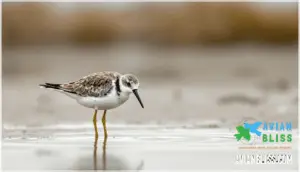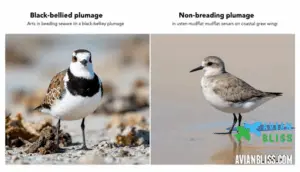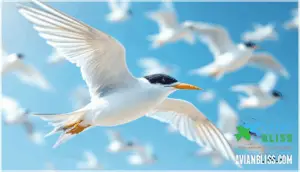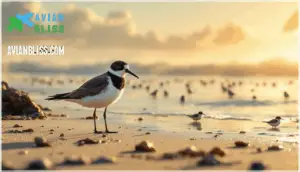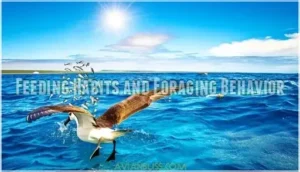This site is supported by our readers. We may earn a commission, at no cost to you, if you purchase through links.

These medium-sized plovers, stretching about 28–29 cm from bill to tail, master the art of seasonal disguise: their drab winter plumage gives way to bold black bellies and checkerboard backs when they return to Arctic breeding grounds.
Whether you spot them sprinting across tidal flats in their distinctive run-stop-peck rhythm or catch the flash of their black wingpits in flight, learning to identify these travelers reveals insights into their extraordinary journey from polar tundra to tropical shores.
Table Of Contents
- Key Takeaways
- Black-bellied Plover Identification and Features
- Habitat and Geographic Distribution
- Feeding Habits and Foraging Behavior
- Breeding and Life Cycle
- Conservation Status and Threats
- Frequently Asked Questions (FAQs)
- Where do Black-bellied Plovers live?
- Are Black-bellied Plovers rare?
- What are some fun facts about the Black-bellied Plover?
- What’s the difference between a Black-bellied Plover and a golden plover?
- How long do black-bellied plovers typically live?
- What are the main predators of black-bellied plovers?
- How do black-bellied plovers communicate with each other?
- Are there any cultural or historical significance to black-bellied plovers?
- How do black-bellied plovers communicate vocally?
- What are their natural predators and threats?
- Conclusion
Key Takeaways
- Black-bellied Plovers undergo dramatic seasonal transformations, shifting from drab gray-brown winter plumage to striking black bellies and checkered backs during the Arctic breeding season, making them masters of seasonal camouflage.
- These shorebirds undertake extraordinary hemispheric migrations spanning from Arctic tundra breeding grounds to tropical wintering zones, traveling nonstop distances of 3,400+ miles and relying on specialized stopover sites for refueling.
- The species’ population has declined over 50% in five decades, dropping to approximately 840,000 individuals worldwide, driven by habitat loss, coastal development, pollution, and climate-induced phenological mismatches between chick hatching and prey availability.
- Black-bellied Plovers employ a distinctive "run-stop-peck" foraging technique relying on acute visual detection within a 15-20 cm radius rather than deep probing, allowing them to adapt their diet from Arctic insects to coastal marine invertebrates depending on seasonal availability.
Black-bellied Plover Identification and Features
Spotting a Black-bellied Plover isn’t too hard once you know what to look for. You’ll need to recognize its size, plumage changes through the year, and a few key field marks that set it apart from other shorebirds.
Here’s what helps you nail the ID every time.
Size, Shape, and Measurements
When you’re sizing up a black-bellied plover, you’ll notice these key plumage proportions and measurements right away:
- Bird size: 28–29 cm (11–11.4 in) long, weighing 160–277 g
- Wingspan: 59–60 cm, roughly double body length for efficient flight
- Bill morphology: Short, thick bill 24–34 mm long, built for probing mudflats
- Leg structure: Moderately long tarsi (40–47 mm) with unwebbed feet
- Wing adaptations: Pointed primaries 170–180 mm long enable long-distance migration
Sexual dimorphism is minimal—males and females look nearly identical in size and shape.
Breeding Vs. Non-breeding Plumage
Beyond just size and shape, you’ll see dramatic plumage variations between seasons. During breeding season, males sport striking black bellies bordered by white crowns and checkered backs—perfect breeding signals on Arctic tundra. After nesting, plumage molting shifts them to drab gray-brown for seasonal camouflage on mudflats. Females show similar patterns but with mottled tones. Juvenile plumage features crisper spotting than adults in nonbreeding season.
| Feature | Breeding | Non-breeding |
|---|---|---|
| Belly | Solid black | Pale whitish-gray |
| Face/crown | Black with white border | Uniform gray-brown |
| Back pattern | Bold checkered contrast | Subtle mottled tones |
Black wingpits stay visible year-round—your reliable plumage identification marker.
Distinctive Field Marks
You’ll spot Black-bellied Plovers by their black axillaries—those dark "wingpits" visible in flight year-round. Look for bold white wing stripes and a white rump with black tail bars when they fly overhead. Their large head, thick neck, and short conical bill create a distinctive "bull-headed" profile.
Watch for their sentinel behavior too—they’re often the first to sound alarm calls, warning other shorebirds of danger.
Comparison to Similar Shorebirds
When you’re piecing together shorebird IDs, knowing what sets the Black-bellied Plover (Pluvialis squatarola) apart from look-alikes helps you avoid mix-ups. Here’s how it stacks up:
- American Golden-Plover – Smaller (23–26 cm), with gray—not black—wingpits and slimmer bill (20–23 mm)
- Semipalmated Plover – Half the size, lacks black axillaries entirely
- Killdeer – Sports two black breast bands instead of solid black underparts
- Western Willet – Longer bill (~50 mm), different wing pattern in flight
- Grey Plover – Basically the same bird, just the Eurasian population
Black-bellied Plovers also forage more slowly, taking 2–3 seconds longer between movements than smaller plovers.
Habitat and Geographic Distribution
If you want to track down Black-bellied Plovers, you’ll need to know where they spend their time throughout the year. These birds follow a predictable pattern, moving between Arctic breeding grounds and coastal wintering areas across two continents.
Let’s look at the specific habitats and regions where you’re most likely to spot them.
Breeding Grounds in The Arctic
You’ll find Black-bellied Plovers nesting across the Arctic tundra from Alaska to Eurasia, roughly between 60°N and 75°N latitude. These birds prefer lowland areas below 500 meters where sparse vegetation—dwarf birch, arctic willow, and moss—keeps sightlines open for spotting predators.
Site fidelity brings pairs back to the same nesting sites each year, where they time egg-laying with June snowmelt. Climate influence is significant—persistent snow can reduce nesting habitat by 30%, while coastal microclimates offer earlier snowmelt and better conditions. Regional variations exist: Alaskan birds favor sedge tundra, while eastern populations choose wetter zones.
| Breeding Feature | Details |
|---|---|
| Territory Size | 10–20 hectares per pair |
| Nest Construction | Shallow scrapes lined with lichens and pebbles |
| Clutch Size | Four eggs per pair |
| Incubation Period | 26–27 days |
Wintering and Migratory Ranges
After breeding, you’ll track Black-bellied Plovers through remarkable migration patterns spanning hemispheres. Fall migration begins late July, with flight performance reaching 3,460–3,960 miles nonstop over five to six days.
Wintering locations stretch from southern Canada to Brazil—a 40° longitudinal spread showing striking geographic variation. Stopover ecology involves week-long refueling at sites like Lake Erie and the Saint Lawrence River, where avian migration timing peaks in late April through early May.
The eggs are incubated by both parents for a period of 26-27 days.
Preferred Coastal and Inland Habitats
Along coastal ecosystems, you’ll encounter Black-bellied Plovers in mudflat ecology hotspots where intertidal zones support large aggregations—San Diego Bay hosts 500–600 individuals weekly during winter.
Migratory stopovers occur at inland wetlands, flooded pastures, and sod farms, demonstrating striking habitat adaptation. This shorebird exhibits habitat variability, shifting between coastal areas and agricultural landscapes depending on tide cycles and food availability.
They forage for invertebrate prey in marine mudflat habitats.
Feeding Habits and Foraging Behavior
You’ll want to watch how Black-bellied Plovers (Pluvialis squatarola) hunt for their meals—they’ve developed some pretty efficient techniques.
Their feeding habits shift with the seasons, and they’ve got built-in adaptations that help them find food in challenging coastal environments. Here’s what you need to know about how these shorebirds fuel up throughout the year.
Typical Foraging Techniques
You’ll spot Black-bellied Plovers using a distinctive "run-stop-peck" method—they dash 2 to 5 meters, freeze for a second or two, then visually scan for prey before pecking at the surface. Visual foraging relies on sharp eyesight rather than deep probing, making tidal foraging incredibly effective when mudflats provide clear views of prey.
- They peck about 5.4 times per minute during best mid-tide feeding periods
- Prey detection works within a 15 to 20 cm radius using acute vision
- Energetic adaptations include running speeds of 0.6 to 0.8 meters per second
- Habitat strategies shift between coastal mudflats and farm fields depending on tide cycles
Diet Composition Across Seasons
Your diet shifts dramatically with the seasons, reflecting seasonal prey availability. During Arctic insect consumption peaks, you’ll rely on fly and beetle larvae (68–85% of stomach contents). Once you head to coastal areas, coastal invertebrate reliance kicks in—marine worms and bivalves dominate (82–91% of dietary biomass). Migration diet shifts bring earthworms and grasshoppers into the mix, with non-marine invertebrates rising 12–27% at inland stopovers.
| Season | Primary Diet Components |
|---|---|
| Breeding (Arctic) | Insect larvae, beetles, moths (70%+) |
| Winter (Coastal) | Marine worms, bivalves, crustaceans (80%+) |
| Spring Migration | Earthworms, cutworms, polychaetes (mixed) |
| Fall Migration | Grasshoppers, marine invertebrates (varied) |
Diet biomass analysis shows you’re flexible, taking advantage of whatever invertebrates are most abundant locally.
Adaptations for Finding Prey
You’ve got specialized tools for tracking down prey on exposed mudflats and shorelines. Visual search drives your foraging behavior—those large eyes scan substrates with precision, letting you spot invertebrates from a distance before running in to peck. Eye adaptations include broad monocular fields (177° per eye) and a narrow binocular zone (15° horizontal) that centers on your bill tip, ensuring accurate prey detection and bill placement.
Here’s what makes your feeding habits so effective:
- Stop-run-peck technique maximizes prey encounters across tidal flats
- Night foraging capability maintains high pecking rates when prey surfaces after dark
- Substrate adaptations let you adjust giving-up time based on local prey density
- Frontal vision overlap guides precise strikes on worms and crustaceans
- Selective targeting focuses effort on larger prey in high-density zones
This plover diet and habitat match keeps you efficient across changing conditions.
Breeding and Life Cycle
Regarding reproduction, Black-bellied Plovers (Pluvialis squatarola) follow a fascinating pattern that takes them to some of the most remote corners of the Arctic. Understanding their breeding cycle gives you insight into how these shorebirds balance survival in harsh tundra conditions with raising their offspring.
Let’s explore the key stages of their nesting and family life.
Nesting Site Selection
When choosing nesting sites, Black-bellied Plovers (Pluvialis squatarola) favor dry, elevated areas in the Arctic tundra with excellent visibility. Males scrape depressions 13–14 cm wide in gravel, moss, or lichen substrates, which females line with plant material. Nest sites on slight ridges show 20–30% better survival than low-lying spots, highlighting the importance of tundra topography. Social spacing keeps nests roughly 400–500 meters apart, reducing territorial conflicts and protecting critical nesting areas from predators like foxes and jaegers through strategic placement and open sightlines.
| Nest Site Feature | Typical Characteristics | Breeding Behavior Advantage |
|---|---|---|
| Substrate | Gravel, moss, lichens, pebbles | Insulation and drainage |
| Elevation | Slight ridges or hummocks | Predator avoidance through visibility |
| Vegetation Height | Under 10 cm tall | Early threat detection |
| Spacing Distance | 400–500 meters apart | Reduces territorial aggression |
| Proximity to Water | Near shallow pools/wetlands | Efficient foraging access |
Climate impacts increasingly affect these nesting sites as warming temperatures advance snowmelt timing, shifting nest initiation earlier by several days per decade.
Courtship and Mating Behavior
Once males secure nesting territories, courtship begins with elaborate aerial displays. You’ll see males performing slow "butterfly flights" with exaggerated wingbeats overhead.
On the ground, males rush toward females in "torpedo runs," heads low and tails fanned, combining visual and vocal signals for mate selection. Copulation follows accepted displays, with mating success exceeding 90% in stable territories.
After copulation, both parents share incubation duties in alternating shifts, establishing parental roles that continue through chick development.
Egg Laying and Incubation
After copulation, females begin nesting, producing clutch sizes of 3 to 4 eggs at intervals close to two days. The eggs display pinkish to brownish tones with dark spots.
Both parents share incubation roles equally, alternating shifts for 23 to 27 days under Arctic influences like subfreezing temperatures and short summers.
Hatch timing is synchronized within 24 hours, completing the blackbellied plover life cycle’s breeding phase before chicks emerge precocial and ready to forage.
Chick Development and Parental Care
Once chicks hatch, both parents share care equally for roughly two weeks, with males incubating by day and females at night. After 14 days, females depart, leaving males to guide downy young until fledging at 23 to 35 days.
Growth rate accelerates rapidly in the first two weeks as chicks develop independent feeding skills. Fledging success exceeds 70% under favorable conditions, though chick mortality peaks within the first 72 hours due to predation by Arctic foxes and jaegers.
Conservation Status and Threats
The black-bellied plover isn’t in immediate danger, but it’s not home free either. Like many shorebirds, this species faces real pressures from habitat loss, pollution, and shifting climates.
Let’s look at what’s happening with their populations and what’s being done to keep them around.
Current Population Trends
The global population of Black-bellied Plovers (Pluvialis squatarola) tells a sobering story. Around 840,000 individuals remain worldwide, but long-term changes show a decline exceeding 50% over five decades—earning the species "Orange Alert Tipping Point" status in 2025.
Black-bellied Plover populations have plummeted over 50% in five decades, with only 840,000 individuals remaining worldwide and the species now at critical tipping point status
- Global estimates place 40% of breeding birds in North America’s Arctic regions
- Regional variations reveal stable Alaskan populations but continued eastern Arctic decreases
- Climate influences and habitat shifts reduce monitoring confidence, especially across remote breeding grounds
You’ll find conservation challenges intensifying as Arctic warming disrupts nesting success and coastal erosion threatens wintering habitat.
Habitat Loss and Human Impact
Across intertidal zones, habitat loss and human disturbance combine to devastate Black-bellied Plover populations. You’ll see this crisis unfold where coastal development and habitat fragmentation reduce tidal flats by 20–70% in key regions.
Pollution effects from oil spills and industrial runoff degrade foraging grounds, while recreational activity forces birds to abandon prime feeding areas.
These interconnected threats exacerbate habitat and breeding failures, demanding urgent conservation efforts before climate change intensifies coastal erosion further.
Effects of Climate Change
Climate change reshapes Black-bellied Plover survival through Arctic warming, altered migration patterns, and sea level rise. You’ll witness breeding seasons advance 6 days per °C temperature increase, while habitat destruction eliminates critical coastal ecosystems.
These climate impacts create phenological mismatches between chick hatching and prey availability, threatening populations already reduced by 50% over five decades. This decline occurs across diminishing avian migration corridors and eroding tidal foraging zones.
Conservation Measures and Monitoring Efforts
You’ll benefit from coordinated conservation initiatives spanning hemispheric migration patterns through frameworks like the Western Hemisphere Shorebird Reserve Network and U.S. Shorebird Conservation Plan. Wildlife protection depends on satellite-based species tracking—one Black-bellied Plover flew 3,400 miles nonstop from Brazil to North Carolina—guiding habitat restoration across Arctic breeding grounds and coastal wintering sites.
Conservation planning integrates tidal wetland management with climate adaptation strategies, though wildlife conservation efforts face challenges as shorebird conservation efforts target a 70% recovery goal by 2050.
Frequently Asked Questions (FAQs)
Where do Black-bellied Plovers live?
You’ll find Black-bellied Plovers (Pluvialis squatarola) in Arctic tundras during breeding season, then along coastal areas worldwide during migration and winter.
Their geographic range spans from northern Alaska and Canada’s breeding sites to beaches, mudflats, and estuaries across continents, though habitat destruction increasingly threatens these shorebird habitats.
Are Black-bellied Plovers rare?
Globally, this shorebird species isn’t rare—populations hover around 840,000 individuals. However, regional rarity is real.
North American populations plummeted 80-100% at some sites since the 1980s due to habitat loss and climate change, making conservation efforts critical.
What are some fun facts about the Black-bellied Plover?
You’ll spot these shorebirds across six continents during winter migration patterns. Their large eyes help them forage even at night—especially under full moons, showcasing impressive Arctic adaptations and plover intelligence.
What’s the difference between a Black-bellied Plover and a golden plover?
You’ll notice the difference right away—Black-bellied Plovers are stockier with thicker bills and dark legs, while golden-plovers are slimmer with longer, darker legs.
Their breeding plumage also sets them apart: Black-bellied show bold black-and-white checkering, whereas American Golden-Plovers display golden-spangled backs.
How long do black-bellied plovers typically live?
Black-bellied plovers generally live 12 to 15 years in the wild. Annual adult survival rates reach 75–80%, with the oldest known individual documented at 14 years through U.S. Geological Survey banding data.
This longevity reflects their delayed maturity and migration endurance strategies.
What are the main predators of black-bellied plovers?
Several predators threaten black-bellied plovers at different life stages. Avian threats include gulls, crows, peregrine falcons, merlins, and snowy owls—with gulls and crows responsible for roughly half of nest predation events.
Mammalian threats encompass coyotes, foxes, raccoons, and skunks that breach nest protection and attack eggs and chicks.
Predation accounts for about 64% of nest failures, making it the primary conservation challenge for this shorebird species.
How do black-bellied plovers communicate with each other?
These shorebirds rely on an elaborate vocal repertoire to communicate. Sharp alarm calls warn of predators, while mellower contact whistles maintain flock cohesion. During breeding, males emit high-pitched piping calls to establish territory and attract mates.
Visual displays—including aerial maneuvers and striking black-and-white breeding plumage—reinforce these messages.
Parents and chicks exchange peeping sounds for parental care coordination, creating a thorough avian display system supporting survival and reproduction.
Are there any cultural or historical significance to black-bellied plovers?
A paradox emerges: this Arctic nester shaped human culture across centuries, yet most know nothing of it. Plovers held profound symbolic weight, representing adaptability and resilience in migration.
Historically hunted for meat and feathers until 1920s regulations intervened, they inspired Audubon’s ornithological art.
Indigenous communities, particularly Inupiat groups, incorporated them into subsistence practices and seasonal folklore, embedding these shorebirds into ecological knowledge systems.
How do black-bellied plovers communicate vocally?
These shorebirds produce varied calls—double-note sequences, flight calls, and alarm signals—generally between 1–11 kHz. Vocal activity peaks during spring and fall migration, especially at dawn and dusk, enabling flock coordination.
Habitat type influences call structure, while acoustic monitoring reveals migration corridors critical for conservation planning.
What are their natural predators and threats?
Ground-nesting plovers face serious threats from Arctic foxes, raccoons, and skunks that destroy eggs and chicks. Coastal development wipes out critical mudflat habitat where they forage and rest during migration. Pollution contaminates their food sources, while climate change reshapes Arctic breeding grounds. These combined pressures have triggered population declines that demand immediate conservation action.
Conclusion
Like a migratory bird itself, understanding the black-bellied plover requires you to track its dual nature—from Arctic breeding grounds to wintering coasts, this species embodies adaptation’s power. You’ve now seen how identification, habitat shifts, and feeding strategies weave together across seasons.
As climate change and habitat loss threaten these journeys, your awareness becomes action. Protecting tidal flats and coastal wetlands means protecting plovers’ survival. The next time you spot one sprinting across mudflats, you’ll recognize not just a bird, but a symbol of nature’s resilience—and your role in preserving it.
- https://nationalzoo.si.edu/migratory-birds/species-profile-black-bellied-plover
- https://ccbbirds.org/2016/01/11/black-bellied-plovers-tracked-to-wintering-grounds/
- https://www.allaboutbirds.org/guide/Black-bellied_Plover/overview
- https://www.audubon.org/field-guide/bird/black-bellied-plover
- https://datarepository.movebank.org/entities/datapackage/115b841d-db72-423f-b853-d71d2cfdecb6

